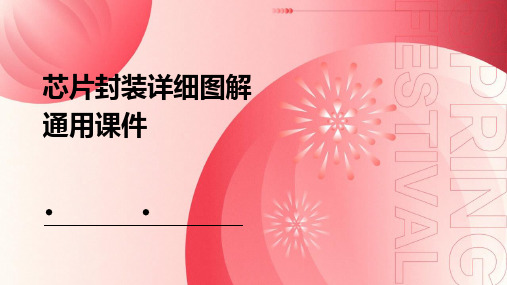微电子芯片封装第二讲
- 格式:ppt
- 大小:3.73 MB
- 文档页数:35
![微电子封装技术讲义06.07[1]](https://img.taocdn.com/s1/m/8423da2c5acfa1c7aa00ccc4.png)

Microelectronics packaging technology(R eview contents)Chapter 1:Introduction1.The development characteristics and trends of microelectronics packaging.2.The functions of microelectronics packaging.3.The levels of microelectronics packaging technology.4.The methods for chip bonding.Chapter 2:Chip interconnection technologyIt is one of the key chapters1.The Three kinds of chip interconnection, and their characteristics and applications.2.The types of wire bonding (WB) technology, their characteristics and working principles.3.The working principle and main process of the wire ball bonding.4.The major materials for wire bonding.5.Tape automated bonding (TAB) technology:1)The characteristic and application of TAB technology.2)The key materials and technologies of TAB technology.3)The internal lead and outer lead welding technology of TAB technology.6. Flip Chip Bonding (FCB) Technology1)The characteristic and application of flip chip bonding technology2)UBM and multilayer metallization under chip bump;UBM’s structure and material, and the roles ofeach layer.3)The main fabrication method of chip bumps.4)FCB technology and its reliability.5)C4 soldering technology and its advantages.6)The role of underfill in FCB.7)The interconnection principles for Isotropic and anisotropic conductive adhesive respectively. Chapter 3: Packaging technology of Through-Hole components1.The classification of Through-Hole components.2.Focused on:DIP packaging technology, including its process flow.3.The characteristics of PGA.Chapter 4:Packaging technology of surface mounted device (SMD)1.The advantages and disadvantages of SMD.2.The types of SMD.3.The main SMD packaging technologies, focused on:SOP、PLCC、LCCC、QFP.4.The packaging process flow of QFP.5.The risk of moisture absorption in plastic packages, the mechanism of the cracking caused by moistureabsorption, and solutions to prevent for such failure.Chapter 5:Packaging technology of BGA and CSP1.The characteristics of BGA and CSP.2.The packaging technology for PBGA,and its process flow.3.The characteristics of packaging technology for CSP.4.The reliability problems of BGA and CSP.Chapter 6:Multi-Chip Module(MCM)1.The classification and characteristics of MCM2. The assembly technology of MCM.Chapter 7:Electronic packaging materials and substrate technology1. The classification of the materials for electronic packaging, the main requirements for packagingmaterials.2. The types of metals in electronic packaging, and their main applications.3. The main requirements for polymer materials in electronic packaging.4.Classification of main substrate materials, and the major requirements for substrate materials.Chapter 8:Microelectronics packaging reliability1.The basic concepts of electronic packaging reliability.2.The basic concepts for failure mode and failure mechanism in electronic packaging.3.Main failure (defect) modes (types) of electronic packaging.4.The purpose and procedure of failure analysis (FA) ;Common FA techniques (such as cross section, dyeand pry, SEM, CSAM ...).5 The purpose and key factors (such as stress level, stress type …) to design accelerated reliability test. Chapter 9:Advanced packaging technologies1.The concept of wafer level packaging (WLP) technology.2.The key processes of WL-CSP.3.The concept and types of the 3D packaging technologies.Specified Subject 1:LED packaging technology1. Describe briefly the four ways to achieve LED white light, and how they are packaged?2. Describe briefly the difference and similar aspects (similarity) between LED packaging andmicroelectronics packaging.3. And also describe briefly the development trend for LED package technology and the whole LED industryrespectively.Specified Subject 2:MEMS packaging technology1.The differences between micro-electro-mechanical system (MEMS) packaging technology and theconventional microelectronics packaging technologies.2.The function requirements of MEMS packaging.Extra requirement:The common used terms (Abbreviation) for electronic packaging.。

电子封装与表面组装技术第一章概述电子封装是一个富于挑战、引人入胜的领域。
它是集成电路芯片生产完成后不可缺少的一道工序,是器件到系统的桥梁。
封装这一生产环节对微电子产品的质量和竞争力都有极大的影响。
按目前国际上流行的看法认为,在微电子器件的总体成本中,设计占了三分之一,芯片生产占了三分之一,而封装和测试也占了三分之一,真可谓三分天下有其一。
封装研究在全球范围的发展是如此迅猛,而它所面临的挑战和机遇也是自电子产品问世以来所从未遇到过的;封装所涉及的问题之多之广,也是其它许多领域中少见的,它需要从材料到工艺、从无机到聚合物、从大型生产设备到计算力学等等许许多多似乎毫不关连的专家的协同努力,是一门综合性非常强的新型高科技学科。
封装最初的定义是:保护电路芯片免受周围环境的影响(包括物理、化学的影响)。
1.芯片封装是利用(膜技术)及(微细加工技术),将芯片及其他要素在框架或基板上布置、粘贴固定及连接,引出接线端子并通过可塑性绝缘介质灌封固定,构成整体结构的工艺。
电子封装工程:将基板、芯片封装体和分立器件等要素,按电子整机要求进行连接和装配,实现一定电气、物理性能,转变为具有整机或系统形式的整机装置或设备。
2.集成电路封装的目的:在于保护芯片不受或者少受外界环境的影响,并为之提供一个良好的工作条件,以使集成电路具有稳定、正常的功能。
3.芯片封装所实现的功能:电源分配;信号分配;散热通道;机械支撑;环境保护4.在选择具体的封装形式时主要考虑四种主要设计参数:性能,尺寸,重量,可靠性和成本目标。
5.封装工程的技术的技术层次第一层次,又称为芯片层次的封装,是指把集成电路芯片与封装基板或引脚架之间的粘贴固定电路连线与封装保护的工艺,使之成为易于取放输送,并可与下一层次的组装进行连接的模块元件。
第二层次,将数个第一层次完成的封装与其他电子元器件组成一个电子卡的工艺。
第三层次,将数个第二层次完成的封装组成的电路卡组合成在一个主电路版上使之成为一个部件或子系统的工艺。


